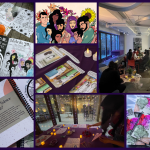 Restaurant Week has returned to DC and each time I brave a packed restaurant for a prix fixe meal, I have flashbacks to one of my first experiences in the restaurant industry. Back before the Curse of the Bambino was broken, I worked in a popular restaurant that was about a block away from Fenway Park. Always a busy place, we’d get particularly slammed on the opening day of the Red Sox’s season. We’d open early in the morning and serve “breakfast pizza” and beer. This was followed by lunch pizza and beer. And then there’d be beer for dinner. The secret to serving hundreds of hungry Red Sox fans seemed to be a good sense of humor, speed, and the ability to keep your butt away from grabby hands (or at least a manager who was understanding when beer ended up in the lap of someone with grabby hands).
Restaurant Week has returned to DC and each time I brave a packed restaurant for a prix fixe meal, I have flashbacks to one of my first experiences in the restaurant industry. Back before the Curse of the Bambino was broken, I worked in a popular restaurant that was about a block away from Fenway Park. Always a busy place, we’d get particularly slammed on the opening day of the Red Sox’s season. We’d open early in the morning and serve “breakfast pizza” and beer. This was followed by lunch pizza and beer. And then there’d be beer for dinner. The secret to serving hundreds of hungry Red Sox fans seemed to be a good sense of humor, speed, and the ability to keep your butt away from grabby hands (or at least a manager who was understanding when beer ended up in the lap of someone with grabby hands).
When I was doing my job well, none of my customers knew how frazzled I was or how hard I was working – and that’s sort of the double-edged sword of making a job look easy. Working in a restaurant is tough. Everyone – from the hostess at the front of the house to the food preparers at the back of the house – is on their feet for hours at a time and is constantly moving. There’s always something to carry and those who work in the kitchen are enduring extreme heat.
If you’re having a great dining experience, you won’t know any of that. You also won’t know if the cook is sick, if your server isn’t being fairly paid, or if your food runner can’t get a promotion because of gender or race discrimination.
Restaurant Opportunities Center-DC (ROC-DC), however, believes that you should educate yourself about where you eat. A Grantee Partner of The Women’s Foundation, ROC-DC is a membership-based worker center dedicated to winning improved conditions and raising industry standards for all D.C. restaurant workers. They’ve also released a diners’ guide that makes it easy for customers to evaluate more than 150 restaurants nationwide.
“More than half of all restaurant workers earn incomes below the federal poverty line, and workers of color are concentrated in the industry’s lowest-wage positions,” according to Restaurant Opportunities Centers United. Women make up a slight majority of all restaurant employees.
Some restaurants don’t have paid sick days, which means that employees go to work even when they’re sick and there are signs of discrimination.
“Something that’s very chilling to us… [is that] in DC, there’s nearly a 50% wage differential between white women and women of color in the restaurant industry,” says Bonnie Kwon, a coordinator at ROC-DC.
Fortunately, there are plenty of restaurants that are committed to providing employees with fair compensation and a safe work environment. The diners’ guide rates restaurants and lists those that pay fair wages and offer benefits like sick days. In addition to using the diners’ guide, Bonnie suggests that you ask servers and managers what their policies are and how much staff is paid. “Be an aware, conscious consumer,” she adds.
If you’re headed out to enjoy a meal during restaurant week or at any other time, I suggest taking a quick look at the Diners’ Guide 2012, which is available for free online. The more enjoyable your meal, the more likely it is that the restaurant staff is working extremely hard to make the experience a good one. They, like all of us, deserve the respect and dignity of a fair work place.
One more thing – even though I made a joke about it earlier, putting your hands on a waitress or waiter is not funny; it’s sexual harassment, so be sure to tip and keep your hands off your server.


